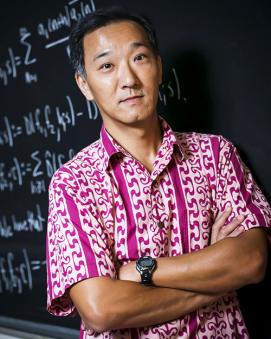Ken Ono
Why does Ramanujan, "The man who knew infinity," matter?
December 7-8, 2017
Public Lecture
Reception: 4:30pm
Talk: 5:00pm
Location: Crane Room, Paige Hall
Abstract: This lecture is about Srinivasa Ramanujan, "The Man Who Knew Infinity." Ramanujan was a self-trained two-time college dropout who left behind 3 notebooks filled with equations that mathematicians are still trying to figure out today. He claimed that his ideas came to him as visions from an Indian goddess. This lecture is about why Ramanujan matters. The speaker was an Associate Producer of the film "The Man Who Knew Infinity" (which starred Dev Patel and Jeremy Irons) about the life of Ramanujan. He will share clips from the film.
Polya's program for the Riemann Hypothesis and related problems
December 8, 2017
Colloquium
Talk: 12:30pm
Reception: 1:30pm
Location: Crane Room, Paige Hall
Abstract: In 1927 Polya proved that the Riemann Hypothesis is equivalent to the hyperbolicity of Jensen polynomials for Riemann's Xi-function. This hyperbolicity has only been proved for degrees d=1, 2, 3. We prove the hyperbolicity of 100% of the Jensen polynomials of every degree. We obtain a general theorem which models such polynomials by Hermite polynomials. This theorem also allows us to prove a conjecture of Chen, Jia, and Wang on the partition function. This is joint work with Michael Griffin, Larry Rolen, and Don Zagier.
Can't you just feel the moonshine?
December 8, 2017
Colloquium
Talk: 4:00pm
Location: Bromfield-Pearson 101
Reception: 5:00pm
Location: Bromfield-Pearson, Clarkson Conference Room
Abstract: Borcherds won the Fields medal in 1998 for his proof of the Monstrous Moonshine Conjecture. Loosely speaking, the conjecture asserts that the representation theory of the Monster, the largest sporadic finite simple group, is dictated by the Fourier expansions of a distinguished set of modular functions. This conjecture arose from astonishing coincidences noticed by finite group theorists and arithmetic geometers in the 1970s. Recently, mathematical physicists have revisited moonshine, and they discovered evidence of undiscovered moonshine which some believe will have applications to string theory and 3d quantum gravity. The speaker and his collaborators have been developing the mathematical facets of this theory, and have proved the conjectures which have been formulated. These results include a proof of the Umbral Moonshine Conjecture, and Moonshine for the first sporadic finite simple group which does not occur as a subgroup or subquotient of the Monster. The most recent Moonshine (announced here) yields unexpected applications to the arithmetic elliptic curves thanks to theorems related to the Birch and Swinnerton-Dyer Conjecture and the Main Conjectures of Iwasawa theory for modular forms. This is joint work with John Duncan, Michael Griffin and Michael Mertens.
The Norbert Wiener Lectures were initially funded by an anonymous gift to the Department of Mathematics. All talks are free and open to the public.
